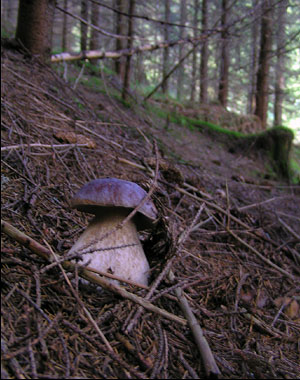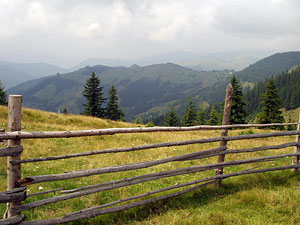- About Ukraine
- Hutsuliya
- Hutsulshchyna
- History and Borders
- The Name and Origin
- Geography and Climate
- The Hutsuls
- Prycarpattia is my Motherland
- Nature and environmental protection
- Kosivshchyna
- Kosiv
- Yavoriv
- Kosmach
- Kuty
- Yabluniv
- Rozhniv
- Rest and Tourism
- Photograph Album
- Library
- Feed
- Store
The majestic hills, the dashing clear streams, the emerald woods with straight and beautiful fir trees that mysteriously shake in the wind and the crystal pure air — this blessed corner of animate nature is called Hutsulshchyna, the pearl of the Hutsulian region is our native Kosivshchyna. It has been attracting people from other countries with the breathtaking charm of its natural richness and historic cultural inheritance of mountain dwellers originality.

Kosivshchyna is not a very large mountain district with Kosiv as a center. It is situated at the foot and partially on the slopes of the Pokutsko-Bukovynsky Carpathians, along the Rybnytsya River, at the elevation of 450–500 m above sea level. The total area of the district is 0.9 thousand square kms. It consists of 42 villages and 2 villages of urban type.

Most of the territory is occupied by the mountain ranges and crossed by the valleys of the Cheremosh, Rybnytsya, Pistynka and Lyuchka Rivers. Over 100 small rivers and mountain streams flow pure water into them. There is drinking water everywhere. But sources of mineral water have a special value in the district. The large number of rivers and streams influence the climate and the wildlife of the territory.

The climate is generally mild: the average temperature in January is -5,4°C and in July +18,6°C. The annual amount of precipitation is 786 mm. But it is worth knowing that the mountain climate changes according to their height above sea level. The temperature is warm and damp at the foot and becomes colder and very damp higher in the mountains. It is quite natural that all these factors affect the flora and fauna a lot. The mountain hills are mainly (about 44,400 ha) covered with forests. The deciduous woods of oak, beech, birch, hornbeam, and ash trees dominate in the lower part of the mountains and the mixed and coniferous trees of fir and spruce are higher.

The hills are naturally abundant with food — raspberries, black berries, and straw berries grow wild and there is a rich variety of mushrooms to be collected every summer and autumn. The mountain meadows are full of officinal plants. Comparatively low mountains and the mild climate create favorable conditions for gardening. Apple, pear, plum and cherry trees along with black currants, gooseberry, and strawberries are grown in the lower part of the mountains.

It is interesting to note that gardening has been developed here since the 17th century, the so-called “royal gardens”. There are nearly 700 species of flora in the district and more than 10 per cent of them are rare. Among them Snowdrop (Galanthus nivalis), Lilly forestry (Lilium mortagon), horsetail big (Equisetum telmateia), Saffron of Hefel (Crocus heuffelianus), Arnica mountainous (Arnica Montana), and some others which are registered in the Red Book.
The fauna of the district is also original and rich. Nowadays such animals as Carpathian deer, wild boar, brown bear, forestry cat, lynx, Carpathian squirrel and salamander demand special protection. Capercailzie, golden eagle, black stork, and other birds are also representatives of the Red Book. Some kinds of animals, birds, fish and plants already disappeared forever. We should protect the others from thoughtless killing and cruelty.
The fairy land of Hutsulshchyna provides peoples with forests and meadows, flowing rivers and curative mineral streams. Today it is the clearest pearl in our country. But it doesn’t mean that ecological problems are not touching the territory at all. The present-day situation in Ukraine demands urgent actions to protect nature, as we should understand well that our survival depends upon the way we treat our environment. Clear water of rivers and streams is the main wealth of Hutsulshchyna. But the riverbeds and banks have become a large scrap heap.
The threat of polluted water does not require much explaining. It provokes different diseases. The riverbeds are often used as a way of transporting wood cut by the poachers. It leads to the pollution of the streams, destruction of the relief, and killing of plants and animals. Besides we should stop the flow of industrial waste into the rivers. It has dropped due to the economic decline, but regeneration of rivers is very slow. Poisonous substances kill fish and plants making rivers and lakes dead.
The protection of nature has become one of the most burning problems in our Ukraine. The accident at Chernobyl Atomic Power Station caused radioactive contamination of a vast territory of Ukraine. It threatens the life of many people. So it’s high time to treat environmental protection as a matter of vital importance. Our country is putting its ecological policy into law with Article 67 of our Constitution that reads: «Citizens of Ukraine are obliged to protect nature and conserve its riches».

The struggle for environmental protection is supported by various public organizations. The leading role in this activity belongs to the Society Zelenyi Svit (Green World). Due to their efforts, a number of nature reserves and green zones have been created. Now Ukraine operates 14 nature reserves and national parks and the Carpathian National Park is one of the best. The first steps are taken but there is still a lot to be done.

